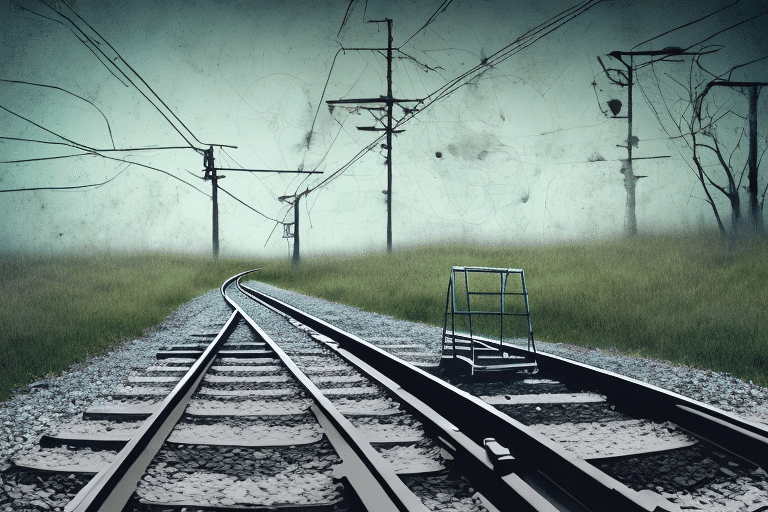Exploring the Mystery of Abandoned Rail Carts on Forgotten Tracks
Railway transportation has been a cornerstone of human development and progress for over two centuries. From the early colonial rail systems that fueled America's economy to the modern high-speed trains that underpin China's vast transportation network, railways have significantly shaped human history. Despite their enduring importance, many railway systems have been abandoned and left to the annals of history. The phenomenon of abandoned rail carts and tracks has captivated enthusiasts and historians alike, offering a glimpse into a bygone era.
A Brief History of Railroad Transportation and Its Significant Impact
The Early Beginnings
The first railroads emerged in the late eighteenth century in the United Kingdom and North America. These early systems utilized horse-drawn carts to transport goods over short distances, laying the foundation for future advancements in rail technology.
The Steam Revolution
By the 1830s, the advent of steam engines revolutionized rail transport. Steam-powered locomotives made transportation faster, cheaper, and more efficient, ushering in the 'railroad age.' According to the Encyclopaedia Britannica, the expansion of railroads played a critical role in the Industrial Revolution, facilitating the movement of raw materials, goods, and people on an unprecedented scale.
Economic Growth and Urban Development
Railway transportation significantly contributed to economic growth and the development of towns and cities. Railroads stimulated economic activity by linking resources, labor, and markets, thereby fostering employment opportunities and social mobility.
The Decline of Railroads
In the 20th century, the rise of automobiles and airplanes led to a decline in railway transportation. Many railroads struggled to compete with the speed and convenience of road and air travel, resulting in the shutdown of numerous rail lines. However, railways remain vital for the transportation of goods over long distances and are experiencing a resurgence as a sustainable alternative to other modes of transport.
The Evolution of Rail Carts: From Steam Engines to Modern Trains
From Horse-Drawn Carts to Steam Locomotives
The evolution of rail carts began with simple, horse-drawn vehicles featuring wooden bases and metal wheels. The introduction of steam engines marked a significant leap forward, enabling locomotives to haul heavier loads over longer distances efficiently.
Transition to Diesel and Electric Engines
In the early 20th century, diesel engines emerged as a more efficient alternative to steam power, eventually replacing steam locomotives. The development of electric trains further enhanced efficiency and environmental friendliness, particularly in urban areas.
High-Speed and Maglev Trains
Advancements continued with the creation of high-speed trains, capable of traveling over 300 km/h, and magnetic levitation (maglev) trains, which utilize powerful magnets to achieve speeds exceeding 600 km/h. These innovations represent the cutting edge of rail technology, pushing the boundaries of speed and efficiency.
Forgotten Rail Tracks: A Glimpse into Abandoned Railway Systems
Historical Significance
Abandoned rail tracks serve as historical artifacts, offering insights into past transportation systems. Exploring these forgotten lines provides a tangible connection to the history of railroads and their role in societal development.
Natural Reclamation
Over time, abandoned railways are reclaimed by nature. Vegetation overtakes the tracks, and rusted metal structures develop a unique patina, creating picturesque landscapes that contrast with their industrial origins.
Biodiversity Renewal
Abandoned railway areas often become habitats for wildlife, fostering new ecosystems. The intersection of man-made structures and natural growth creates diverse environments that support various species.
The Abandoned Rail Cart Phenomenon: Exploring the Reasons Behind It
Technological Advancements
One primary reason for the abandonment of rail carts and tracks is technological progress. As new, more efficient rail technologies emerge, older systems become obsolete and are subsequently abandoned.
Shifts in Transportation Preferences
The preference for road and air transport over rail has also contributed to the decline of many railway systems. The flexibility and speed of automobiles and airplanes have made them more attractive options for both passengers and freight, rendering some rail lines uneconomical to maintain.
Natural Disasters and Environmental Factors
Natural disasters such as floods, landslides, and earthquakes can damage railway infrastructure beyond repair. The high costs associated with restoring these systems often lead to their permanent abandonment.
Discovering the Hidden Treasures Along Abandoned Railway Lines
Exploration Opportunities
Abandoned railway lines are treasure troves for explorers and historians. Hidden within these forgotten tracks are relics such as old stations, derelict warehouses, and remnants of railway construction like sleepers and signaling equipment.
Historical Artifacts
Explorers may uncover artifacts that provide valuable insights into the operational history of railways. These discoveries can include old tools, signage, and even personal items left behind by railway workers and passengers.
Safety Considerations
Despite the allure of exploration, abandoned railway lines can pose significant dangers. Structures may be unstable, and there may be hidden hazards like sharp objects or toxic materials. It is essential to prioritize safety and explore responsibly.
The Fascinating World of Railway Exploration and Urban Exploration
Urban Exploration (Urbex)
Railway exploration is a popular subset of urban exploration, where enthusiasts venture into off-limits areas such as abandoned stations and underground tunnels. This activity allows explorers to experience the hidden and often eerie beauty of forgotten rail systems.
Discovering Hidden Histories
Through railway exploration, enthusiasts can uncover lost histories and artifacts, offering a unique perspective on the evolution of transportation and its impact on urban development.
Safety and Ethical Considerations
Urban explorers must navigate the inherent risks of abandoned sites, including unstable structures and potential encounters with wildlife or trespassers. Adhering to safety protocols and respecting property boundaries are crucial for a safe and responsible exploration experience.
The Risks and Rewards of Exploring Abandoned Rail Carts and Tracks
Potential Hazards
Exploring deserted railway systems comes with various risks, including unstable buildings, hidden debris, and exposure to hazardous materials. Additionally, the remote locations of many abandoned tracks can pose challenges in terms of accessibility and emergency response.
Unique Rewards
Despite the risks, the rewards of exploration are substantial. Discoverers can uncover forgotten histories, connect with the past, and experience a sense of adventure. The unique landscapes and historical artifacts found along abandoned tracks add to the allure of this pursuit.
Exploring the Haunting Beauty of Forgotten Railway Landscapes
Aesthetic Appeal
Abandoned railway landscapes possess a haunting beauty, characterized by rusted tracks, overgrown vegetation, and decaying structures. These scenes offer a stark contrast to the bustling urban environments typically associated with railways.
Photographic Opportunities
The unique aesthetics of abandoned railways make them popular subjects for photographers. The interplay of light and shadow on decaying structures creates visually compelling compositions that capture the essence of forgotten times.
Emotional Resonance
These landscapes evoke a sense of nostalgia and melancholy, prompting reflections on the passage of time and the impermanence of human endeavors. The juxtaposition of nature reclaiming man-made structures serves as a poignant reminder of resilience and change.
The Role of Technology in Preserving the Legacy of Railroad Transportation
Digital Preservation
Advances in technology have enabled the digital preservation of railway systems and abandoned landscapes. High-resolution photography, 3D modeling, and virtual reality allow for detailed documentation and immersive exploration of these sites.
Drone Mapping
Drones play a crucial role in mapping and documenting abandoned railways. They provide comprehensive aerial views, helping researchers and enthusiasts understand the full extent of these forgotten networks. According to a study in the Journal of Rail Transport Studies, drone mapping has become an essential tool in railway preservation efforts.
Archival Databases
Creating and maintaining digital archives ensures that the history and significance of railway systems are accessible to future generations. These databases compile photographs, historical documents, and personal accounts, preserving the rich legacy of rail transportation.
Documenting the Lost Stories and Memories of Abandoned Railways
Historical Documentation
Abandoned railways are repositories of countless stories and memories. Documenting these narratives is essential for preserving the cultural and historical significance of rail transportation. Oral histories, written records, and multimedia accounts contribute to a comprehensive understanding of these systems.
Preserving Personal Histories
Personal stories from railway workers and passengers offer intimate insights into the daily operations and societal impact of railways. These accounts humanize the history of rail transportation, highlighting the personal experiences behind the broader historical trends.
Educational Resources
Documented histories serve as valuable educational resources, informing current and future generations about the evolution of transportation and its role in shaping modern society. Educational institutions and public history projects utilize these documents to teach and engage communities.
Reimagining the Future of Railway Systems through Historic Preservation and Restoration
Historic Preservation Efforts
There is a growing movement dedicated to the historic preservation and restoration of abandoned railway systems. These efforts aim to maintain the structural integrity and historical authenticity of railway sites, ensuring their legacy endures.
Economic Revitalization
Restored railway systems can act as catalysts for economic revitalization. Reopened rail lines can boost local economies by enhancing transportation infrastructure, attracting tourism, and creating job opportunities in restoration projects.
Future Prospects
Reimagining railway systems involves integrating modern technology with historical preservation. Sustainable practices, such as electrification and the use of renewable energy sources, can rejuvenate railways, making them relevant and efficient for future generations.
In conclusion, abandoned rail carts and tracks offer a fascinating window into the history and evolution of railway transportation. Exploring these forgotten systems connects us with the past, highlights the significance of railroads in societal development, and underscores the importance of preserving these legacies for the future. Through responsible exploration, technological preservation, and dedicated restoration efforts, the stories and structures of abandoned railways can continue to inspire and educate for years to come.




















